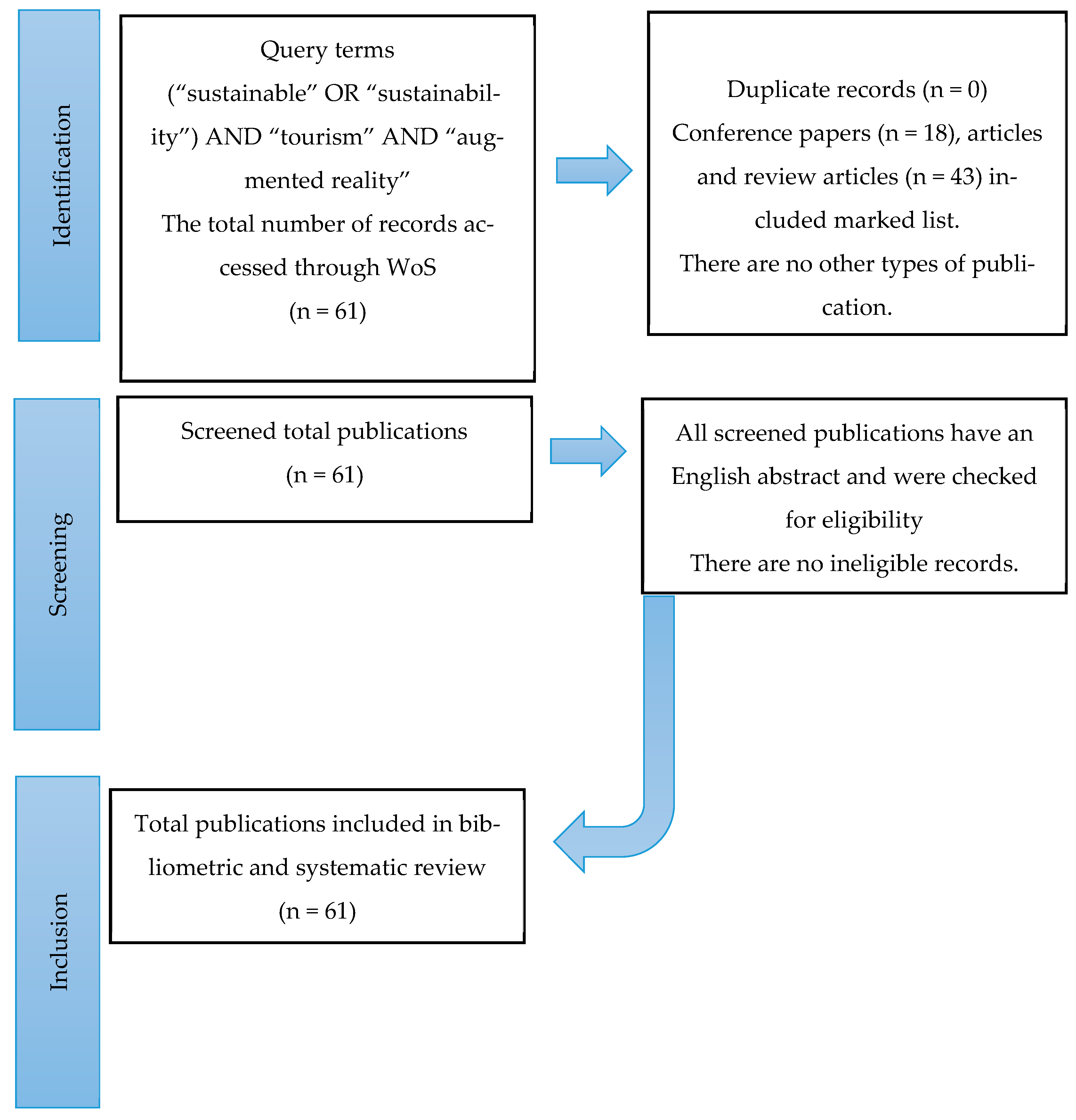A Bibliometric and Systematic Review of Publications on Augmented Reality in Sustainable Tourism
Abstract
1. Introduction
2. Methodology
2.1. Data Search
2.2. Data Extraction
2.3. Data Analysis
3. Results
3.1. Bibliometric Analysis
3.1.1. Publication Distribution and Citations by Year
3.1.2. WoS Publication Categories
3.1.3. Most Cited Authors and Co-Authorship Analysis
3.1.4. Most Productive Countries and Number of Publications by Year
3.1.5. Most Cited Countries
3.1.6. Most Used Author Keywords
3.1.7. Co-Occurrence Analysis of Author Keywords
3.1.8. Most Cited Publications
3.1.9. Co-Citation Analysis of Cited References
3.1.10. Bibliographic Coupling Analysis
3.1.11. Sustainable Development Goals
3.2. Systematic Review
3.2.1. Content Analysis of Publications
3.2.2. Future Research Agenda
4. Discussion
5. Conclusions
Author Contributions
Funding
Acknowledgments
Conflicts of Interest
References
- Sung, E. The effects of augmented reality mobile app advertising: Viral marketing via shared social experience. J. Bus. Res. 2021, 122, 75–87. [Google Scholar] [CrossRef]
- Arunchoknumlap, P.; Jonpradit, S. The impact of augmented reality (AR) advertising on consumer behavior: A comparative study of traditional and immersive marketing approaches. J. Manag. Sci. Sakon Nakhon Rajabhat Univ. 2023, 3, 91–104. [Google Scholar]
- Li, Q.; Zhu, C.; Shi, T. Augmented reality advertising in an e-commerce model with competition. Electron. Commer. Res. Appl. 2021, 49, 101196. [Google Scholar] [CrossRef]
- Ahmed, K.E.; Ambika, A.; Belk, R. Augmented reality magic mirror in the service sector: Experiential consumption and the self. J. Serv. Manag. 2023, 34, 56–77. [Google Scholar] [CrossRef]
- Neuhofer, B.; Buhalis, D.; Ladkin, A. A typology of technology-enhanced tourism experiences. Int. J. Tour. Res. 2014, 16, 340–350. [Google Scholar] [CrossRef]
- Cranmer, E.E.; Dieck, M.C.; Jung, T. The role of augmented reality for sustainable development: Evidence from cultural heritage tourism. Tour. Manag. Perspect. 2023, 49, 101196. [Google Scholar] [CrossRef]
- Jomsri, P. Creative innovation of augmented reality for promote sustainable tourism of Chiang Mai Moat. IOP Conf. Ser. J. Phys. 2019, 1335, 012010. [Google Scholar] [CrossRef]
- Gahlot, P.; Suryavanshi, K.; Gandhi, A.; Raman, R. Augmented reality application for sustainable development- a grounded theory approach. In Proceedings of the International Conference on Sustainable Computing and Smart Systems (ICSCSS 2023), Coimbatore, India, 14–16 June 2023. [Google Scholar]
- Özkul, E.; Kumlu, S.T. Augmented reality applications in tourism. Int. J. Contemp. Tour. Res. 2019, 2, 107–122. [Google Scholar] [CrossRef]
- Han, D.; Jung, T.; Gibson, A. Dublin AR: Implementing augmented reality (AR) in tourism. In Information and Communication Technologies in Tourism; Xiang, Z., Tussyadiah, I., Eds.; Springer International Publishing: Cham, Switzerland, 2014; pp. 511–523. [Google Scholar]
- Han, S.; Yoon, J.H.; Kwon, J. Impact of experiential value of augmented reality: The context of heritage tourism. Sustainability 2021, 13, 4147. [Google Scholar] [CrossRef]
- Bretos, M.A.; Ibáñez-Sánchez, S.; Orús, C. Applying virtual reality and augmented reality to the tourism experience: A comparative literature review. Span. J. Mark. 2024, 28, 287–309. [Google Scholar] [CrossRef]
- Cibilić, I.; Poslončec-Petrić, V.; Tominić, K. Implementing augmented reality in tourism. In Proceedings of the 30th International Cartographic Conference (ICC 2021), Florence, Italy, 14–18 December 2021. [Google Scholar]
- Garzón-Jiménez, R.; Zorio-Grima, A. Sustainability in the food and beverage sector and its impact on the cost of equity. Br. Food J. 2022, 124, 2497–2511. [Google Scholar] [CrossRef]
- Kee, D.M.H.; Lee, J.V.K.; Azlan, I.Y.A.B.; Subramaniam, J.; Koay, J.C.W.; Putri, A.M.; Asthana, R.; Shrivastava, K.; Beg, A. Sustainability in the food and beverage ındustry: A comparative study of Malaysia, India, and Indonesia. Int. J. Tour. Hosp. Asia Pasific (IJTHAP) 2023, 6, 1–17. [Google Scholar] [CrossRef]
- Muhanna, E. Sustainable tourism development and environmental management for developing countries. Probl. Perspect. Manag. 2006, 4, 14–30. [Google Scholar]
- Yazdi, S.K. Sustainable tourism. Am. Int. J. Soc. Sci. 2012, 1, 50–56. [Google Scholar]
- Sgroi, F.; Modica, F. Digital technologies for the development of sustainable tourism in mountain areas. Smart Agric. Technol. 2024, 8, 100475. [Google Scholar] [CrossRef]
- Sugiri, K.G.L.; Mahyuni, L.P. Sustainable tourism practices as a strategy to enhance corporate brand. Int. J. Bus. Econ. Law 2019, 20, 7–17. [Google Scholar]
- Roodposhti, M.S.; Esmaeelbeigi, F. Viewpoints on AR and VR in heritage tourism. Digit. Appl. Archaeol. Cult. Herit. 2024, 33, e00333. [Google Scholar] [CrossRef]
- Loureiro, S.M.C.; Guerreiro, J.; Ali, F. 20 years of research on virtual reality and augmented reality in tourism context: A text-mining approach. Tour. Manag. 2020, 77, 104028. [Google Scholar] [CrossRef]
- Donthu, N.; Kumar, S.; Mukherjee, D.; Pandey, N.; Lim, W.M. How to conduct a bibliometric analysis: An overview and guidelines. J. Bus. Res. 2021, 133, 285–296. [Google Scholar] [CrossRef]
- Nunn, J.; Chang, S. What are the systematic reviews? Wiki J. Med. 2020, 7, 1–11. [Google Scholar] [CrossRef]
- Alsadi, J.; Alkhatib, F.; Antony, J.; Garza-Reyes, J.A.; Tortorella, G.; Cudney, E.A. A systematic literature review with bibliometric analysis of Quality 4.0. TQM J. 2024; ahead-of-print. [Google Scholar] [CrossRef]
- Biasin, M.; Foglie, A.D. Blockchain and smart cities for ınclusive and sustainable communities: A bibliometric and systematic literature review. Sustainability 2024, 16, 6669. [Google Scholar] [CrossRef]
- Mutlu Avinç, G.; Yıldız, A. A bibliometric and systematic review of scientifc publications on metaverse research in architecture: Web of Science (WoS). Int. J. Technol. Des. Educ. 2024, 1–25. [Google Scholar] [CrossRef]
- Pranckutė, R. Web of Science (WoS) and Scopus: The titans of bibliographic ınformation in today’s academic world. Publications 2021, 9, 12. [Google Scholar] [CrossRef]
- Yan, L.; Zhiping, W. Mapping the literature on academic publishing: A bibliometric analysis on WOS. SAGE Open 2023, 13, 21582440231158562. [Google Scholar] [CrossRef]
- Yonfá-Medranda, M.; Sabando-Vera, D.; Pèrez-Gálvez, J.; Jara-Alba, C. Consumer ethnocentrism: Bibliometric analysis and literature review through cognitive structure and mapping of research based on web of science (WoS) and scopus. Cogent Bus. Manag. 2024, 11, 2377320. [Google Scholar] [CrossRef]
- Abayeva, G.A.; Orazayeva, G.S.; Omirbek, S.J.; Ibatova, G.B.; Zakirova, V.G.; Vlasova, V.K. A cross-database bibliometric analysis of ubiquitous learning: Trends, influences, and future directions. Contemp. Educ. Technol. 2023, 15, ep471. [Google Scholar] [CrossRef]
- Kaur, C.D. Research publications: Need for academicians. Asian J. Res. Pharm. Sci. 2013, 3, 220–228. [Google Scholar]
- Page, M.J.; McKenzie, J.E.; Bossuyt, P.M.; Boutron, I.; Hoffmann, T.C.; Mulrow, C.D.; Shamseer, L.; Tetzlaff, J.M.; Akl, E.A.; Brennan, S.E.; et al. The PRISMA 2020 statement: An updated guideline for reporting systematic reviews. BMIJ 2021, 71, 372. [Google Scholar] [CrossRef]
- Aygün, E.B.; Çelik, S. A systematic review on augmented reality supported flipped classrooms studies. Int. J. Hum. Comput. Interact. 2024, 1–15. [Google Scholar] [CrossRef]
- Van Eck, N.J.; Waltman, L. Visualizing bibliometric networks. In Measuring Scholarly Impact: Methods and Practice, 1st ed.; Ding, Y., Rousseau, R., Wolfram, D., Eds.; Springer: Cham, Switzerland, 2014; pp. 285–320. [Google Scholar]
- VOSviewer (2024). Highlights. Available online: https://www.vosviewer.com/features/highlights (accessed on 9 September 2024).
- Van Eck, N.J.; Waltman, L. VOSviewer Manual; Universtiteit Leiden: Leiden, The Netherlands, 2023. [Google Scholar]
- Khirfan, L.; Peck, M.; Mohtat, N. Systematic content analysis: A combined method to analyze the literature on the daylighting (de-culverting) of urban streams. MethodsX 2020, 7, 100984. [Google Scholar] [CrossRef] [PubMed]
- Xie, H.; Zhang, Y.; Wu, Z.; Lv, T. A bibliometric analysis on land degradation: Current status, development, and future directions. Land 2020, 9, 28. [Google Scholar] [CrossRef]
- Web of Science. Web of Science Core Collection: Web of Science Categories. 2023. Available online: https://support.clarivate.com/ScientificandAcademicResearch/s/article/Web-of-Science-Core-Collection-Web-of-Science-Categories?language=en_US (accessed on 9 September 2024).
- Milojević, S. Practical method to reclassify Web of Science articles into unique subject categories and broad disciplines. Quant. Sci. Stud. 2020, 1, 183–206. [Google Scholar] [CrossRef]
- Web of Science (WoS) Core Collection. Sustainable Development Goals. 2024. Available online: https://www.webofscience.com/wos/woscc/analyze-results/c554d7e9-fdbf-4d99-87a4-979205d1472b-010d346f55 (accessed on 20 August 2024).
- Bornmann, L.; Mutz, R.; Neuhaus, C.; Daniel, H.D. Citation counts for research evaluation: Standards of good practice for analyzing bibliometric data and presenting and interpreting results. Ethics Sci. Environ. Politics 2008, 8, 93–102. [Google Scholar] [CrossRef]
- Guo, J.; Xu, J.; Pan, Y. How do location-based AR games enhance value co-creation experiences at cultural heritage sites? A process perspective analysis. Appl. Sci. 2024, 14, 6812. [Google Scholar] [CrossRef]
- Guo, Y.M.; Huang, Z.L.; Guo, J.; Li, H.; Guo, X.R.; Nkeli, M.J. Bibliometric analysis on smart cities research. Sustainability 2019, 11, 3606. [Google Scholar] [CrossRef]
- Ramos, R.; Rita, P.; Moro, S. Exploring the intersections of tourism and hospitality: A review and research agenda. Tour. Manag. Stud. 2024, 19, 27–45. [Google Scholar] [CrossRef]
- Bec, A.; Moyle, B.; Timms, K.; Schaffer, V.; Skavronskaya, L.; Little, C. Management of immersive heritage tourism experiences: A conceptual model. Tour. Manag. 2019, 72, 117–120. [Google Scholar] [CrossRef]
- Kim, D.; Kim, S. The role of mobile technology in tourism: Patents, articles, news, and mobile tour app reviews. Sustainability 2017, 9, 2082. [Google Scholar] [CrossRef]
- Santos, V.; Ramos, P.; Sousa, B.; Valeri, M. Towards a framework for the global wine tourism system. J. Organ. Change Manag. 2022, 35, 348–360. [Google Scholar] [CrossRef]
- Zhuang, X.; Hou, X.; Feng, Z.; Lin, Z.; Li, J. (J.) Subjective norms, attitudes, and intentions of AR technology use in tourism experience: The moderating effect of millennials. Leis. Stud. 2021, 40, 392–406. [Google Scholar] [CrossRef]
- Vela, J.D.E.; Noguė, J.; Govers, R. Visual landscape as a key element of place branding. J. Place Manag. Dev. 2017, 10, 23–44. [Google Scholar] [CrossRef]
- Graziano, T.; Privitera, D. Cultural heritage, tourist attractiveness and augmented reality: Insights from Italy. J. Herit. Tour. 2020, 15, 666–679. [Google Scholar] [CrossRef]
- Sorokina, E.; Wang, Y.C.; Fyall, A.; Lugosi, P.; Torres, E.; Jung, T. Constructing a smart destination framework: A destination marketing organization perspective. J. Destin. Mark. Manag. 2022, 23, 100688. [Google Scholar] [CrossRef]
- Loureiro, S.M.C.; Nascimento, J. Shaping a view on the influence of technologies on sustainable tourism. Sustainability 2021, 13, 12691. [Google Scholar] [CrossRef]
- Bruno, F.; Ricca, M.; Lagudi, A.; Kalamara, P.; Manglis, A.; Fourkiotou, A.; Papadopoulou, D.; Veneti, A. Digital technologies for the sustainable development of the accessible underwater cultural heritage sites. J. Mar. Sci. Eng. 2020, 8, 955. [Google Scholar] [CrossRef]
- Cirulis, A.; De Paolis, L.T.; Tutberidze, M. Virtualization of digitalized cultural heritage and use case scenario modeling for sustainability promotion of national identity. Procedia Comput. Sci. 2015, 77, 199–206. [Google Scholar] [CrossRef]
- WoS Citation Report. WoS Citation Report and Source Data. 2024. Available online: https://www.webofscience.com/wos/woscc/citation-report/a1773cfd-9e97-45f1-9166-a9b7534a3d29-010db74031 (accessed on 28 December 2024).
- tom Dieck, M.C.; Jung, T.H. Value of augmented reality at cultural heritage sites: A stakeholder approach. J. Destin. Mark. Manag. 2017, 6, 110–117. [Google Scholar] [CrossRef]
- Yung, R.; Khoo-Lattimore, C. New realities: A systematic literature review on virtual reality and augmented reality in tourism research. Curr. Issues Tour. 2019, 22, 2056–2081. [Google Scholar] [CrossRef]
- Guttentag, D.A. Virtual reality: Applications and implications for tourism. Tour. Manag. 2010, 31, 637–651. [Google Scholar] [CrossRef]
- Azuma, R.T. A survey of augmented reality. Presence Teleoperators Virtual Environ. 1997, 6, 355–385. [Google Scholar] [CrossRef]
- Martínez-Graña, A.M.; Goy, J.L.; Cimarra, C.A. A virtual tour of geological heritage: Valourising geodiversity using Google Earth and QR code. Comput. Geosci. 2013, 61, 83–93. [Google Scholar] [CrossRef]
- Ajzen, I. From intentions to actions: A theory of planned behavior. In Action-Control: From Cognition to Behavior; Kuhl, J., Beckman, J., Eds.; Springer International Publishing: Cham, Switzerland, 1985; pp. 11–39. [Google Scholar]
- Buhalis, D.; Sinarta, Y. Real-time co-creation and nowness service: Lessons from tourism and hospitality. J. Travel Tour. Mark. 2019, 36, 563–582. [Google Scholar] [CrossRef]
- Li, M.; Yin, D.; Qiu, H.; Bai, B. A systematic review of AI technology-based service encounters: Implications for hospitality and tourism operations. Int. J. Hosp. Manag. 2021, 95, 102930. [Google Scholar] [CrossRef]
- Jiang, S.; Moyle, B.; Yung, R.; Tao, L.; Scott, N. Augmented reality and the enhancement of memorable tourism experiences at heritage sites. Curr. Issues Tour. 2023, 26, 242–257. [Google Scholar] [CrossRef]
- Jung, T.H.; Tom Dieck, M.C. Augmented reality, virtual reality and 3D printing for the co-creation of value for the visitor experience at cultural heritage places. J. Place Manag. Dev. 2017, 10, 140–151. [Google Scholar] [CrossRef]
- Allal-Chėrif, O. Intelligent cathedrals: Using augmented reality, virtual reality, and artificial intelligence to provide an intense cultural, historical, and religious visitor experience. Technol. Forecast. Soc. Chang. 2022, 178, 121604. [Google Scholar] [CrossRef]
- Femenia-Serra, F.; Perles-Ribes, J.F.; Ivars-Baidal, J.A. Smart destinations and tech-savvy millennial tourists: Hype versus reality. Tour. Rev. 2019, 74, 63–81. [Google Scholar] [CrossRef]
- Li, C.-Y.; Fang, Y.-H.; Sukoco, B.M. Value proposition as a catalyst for innovative service experience: The case of smart-tourism destinations. Serv. Bus. 2021, 15, 281–308. [Google Scholar] [CrossRef]
- Chung, N.; Han, H.; Joun, Y. Tourists’ intention to visit a destination: The role of augmented reality (AR) application for a heritage site. Comput. Hum. Behav. 2015, 50, 588–599. [Google Scholar] [CrossRef]
- Bekele, M.K.; Pierdicca, R.; Frontoni, E.; Malinverni, E.S.; Gain, J. A survey of augmented, virtual, and mixed reality for cultural heritage. J. Comput. Cult. Herit. 2018, 11, 1–36. [Google Scholar] [CrossRef]
- Cayla, N.; Hoblėa, F.; Reynard, E. New digital technologies applied to the management of geoheritage. Geoheritage 2014, 6, 89–90. [Google Scholar] [CrossRef]
- Pombo, L.; Marques, M.M. An app that changes mentalities about mobile learning—The EduPARK augmented reality activity. Computers 2019, 8, 37. [Google Scholar] [CrossRef]
- Ariza-Colpas, P.P.; Piñeres-Melo, M.A.; Morales-Ortega, R.C.; Rodriguez-Bonilla, A.F.; Naz, S.; Conterras-Chinchilla, L.C.; Romero-Mestre, M.; Ascanio, R.A.V. Augmented reality and tourism: A bibliometric analysis of new technological bets in the post-COVID era. Sustainability 2023, 15, 15358. [Google Scholar] [CrossRef]
- Streimikiene, D.; Korneeva, E. Economic impacts of innovations in tourism marketing. Terra Econ. 2020, 18, 182–193. [Google Scholar] [CrossRef]
- Plata, A.R.M.; Franco, P.A.C.; Sanchez, J.A.R. Architectural survey, diagnostic, and constructive analysis strategies for monumental preservation of cultural heritage and sustainable management of tourism. Buildings 2022, 12, 1156. [Google Scholar] [CrossRef]
- Hui, X.; Raza, S.H.; Khan, S.W.; Zaman, U.; Ogadimma, E.C. Exploring regenerative tourism using media richness theory: Emerging role of immersive journalism, metaverse-based promotion, eco-literacy, and pro-environmental behavior. Sustainability 2023, 15, 5046. [Google Scholar] [CrossRef]
- González-Delgado, J.Á.; Martínez-Graña, A.; Holgado, M.; Gonzalo, J.C.; Legoinha, P. Augmented reality as a tool for promoting the tourist value of the geological heritage around natural filming locations: A case study in “Sad Hill” (The Good, the Bad and the Ugly Movie, Burgos, Spain). Geoheritage 2020, 12, 34. [Google Scholar] [CrossRef]
- Baktash, A.; Nair, V.; Subramonian, H. Parameters that facilitate tourists’ acceptance in using wearable augmented reality smart glass in Geotourism hotspots. In Proceedings of the 3rd International Hospitality and Tourism Conference (IHTC)/2nd International Seminar on Tourism (ISOT), Bandung, Indonesia, 10–12 October 2016. [Google Scholar]
- Singh, P.; Sharma, M.; Daim, T. Envisaging AR travel revolution for visiting heritage sites: A mixed-method approach. Technol. Soc. 2024, 76, 102439. [Google Scholar] [CrossRef]
- da Silva, A.J.M. In quest of a new AR technology application to enhance the sustainability of cultural tourism: The olive heritage in Madeira through the looking glass of a ‘sandbox’ approach. Eur. J. Tour. Hosp. Recreat. 2021, 11, 66–76. [Google Scholar] [CrossRef]
- Li, X.Z.; Chen, C.C.; Kang, X.; Kang, J. Research on relevant dimensions of tourism experience of intangible cultural heritage lantern festival: Integrating generic learning outcomes with the technology acceptance. Front. Psychol. 2022, 13, 943277. [Google Scholar] [CrossRef]
- Marques, M.M.; Pombo, L. User experience of a mobile app in a city tour game for ınternational doctoral students. Educ. Sci. 2023, 13, 1221. [Google Scholar] [CrossRef]
- Clarivate. Sustainable Development Goals: Mapping the Research Landscape. 2019. Available online: https://clarivate.com/academia-government/lp/navigating-the-structure-of-research-on-sustainable-development-goals-2/ (accessed on 1 August 2024).
- Buhalis, D.; Efthymiou, L.; Uzunboylu, N.; Thrassou, A. Charting the progress of technology adoption in tourism and hospitality in the era of industry 4.0. EuroMed J. Bus. 2024, 19, 1–20. [Google Scholar] [CrossRef]
- dela Cruz, D.R.; Sevilla, J.S.A.; San Gabriel, J.W.D.; Dela Cruz, A.J.P.; Caselis, E.J.S. Design and development of augmented reality (AR) mobile application for Malolos’ Kameztizuhan (Malolos Heritage Town, Philippines). In Proceedings of the IEEE Games, Entertainment, Media Conference (GEM), Galway, Ireland, 15–17 August 2018. [Google Scholar]
- Markopoulos, E.; Limula, M.; Benahmed, G.; Suominen, T. Strategic utilization of the VR and AR technologies for the African cultural heritage promotion and management. In Advances in Creativity, Innovation, Entrepreneurship and Communication of Design; Springer: Cham, Switzerland, 2021. [Google Scholar]
- Chen, W.; Li, D.H.; Li, Y.F. Virtual reality for showcasing sustainable engineering design. In Proceedings of the 2nd International Conference on Environmental and Energy Engineering, Xiamen, China, 1–3 March 2018. [Google Scholar]
- Nag, A.; Mishra, S. Revitalizing mining heritage tourism: A machine learning approach to tourism management. J. Min. Environ. 2024, 15, 1193–1225. [Google Scholar] [CrossRef]
- Jaffar, M.N.; Rahman, A.A.; Hamed, K.R.A.; Ahmad, M.I.; Ritonga, M.; Azam, M.H.N. Development of augmented reality arabic for ıslamic tourism: Sustainable education need analysis. IJAZ ARABI: J. Arab. Learn. 2024, 7, 571–585. [Google Scholar] [CrossRef]
- Cañavate-Cruzado, G.; Melero-Muñoz, F.J.; Garrido-Lova, J.; Gómez-Gómez, M.V.; Bueno-Delgado, M.V. Augmented reality-state of the educational offer and applications for rural tourism. In Proceedings of the 13th International Technology, Education and Development Conference, Valencia, Spain, 1–13 March 2019. [Google Scholar]
- Shukla, V.; Rana, S.; Prashar, S. Examining the potential of virtual and augmented reality in enhancing tourism experiences. Bottom Line, 2024; ahead-of-print. [Google Scholar] [CrossRef]
- Li, S.; Jiang, S. The technology acceptance on AR memorable tourism experience—The empirical evidence from China. Sustainability 2023, 15, 13349. [Google Scholar] [CrossRef]
- Koukopoulos, Z.; Koukopoulos, D. Intelligent management of outdoor cultural events promoting exploitation in smart city environments. In Proceedings of the 4th International Conference of the International-Association-of-Cultural-and-Digital-Tourism, Athens, Greece, 25–27 May 2017. [Google Scholar]
- Triviño-Tarradas, P.; Mohedo-Gatón, A.; Carranza-Cañadas, P.; Hidalgo-Fernandez, R.E. The application of metaverse in the tourism sector as a tool for enhancing sustainability-case study: A medieval ‘perfume burner’ of the local historical museum of Montilla (Cordoba, Spain). Sustainability 2024, 16, 6966. [Google Scholar] [CrossRef]
- Zaifri, M.; Khalloufi, H.; Kaghat, F.Z.; Azough, A.; Zidani, K.A. From earlier exploration to advanced applications: Bibliometric and systematic review of augmented reality in the tourism industry (2002–2022). Multimodal Technol. Interact. 2023, 7, 64. [Google Scholar] [CrossRef]
- Lai, S.Y.; Liu, D.E.; Yeh, Z.F.; Hsu, C.C.; Chang, F.Y.; Tsai, M.Z.; Lin, R.H. Footprints of travel: AIoT and AR enhanced tourist gaming experience in unmanned cultural sites. In Proceedings of the CHI Conference on Human Factors in Computing Systems, Honolulu, HI, USA, 11–16 May 2024. [Google Scholar]
- Scollen, R.; Mason, A. Shark Dive and Hologram Zoo: Two case studies of virtual animal encounters as possible models for sustainable wildlife tourism. Animals 2024, 14, 926. [Google Scholar] [CrossRef]
- Sun, W.; Zhang, F.; Tai, S.; Wu, J.; Mu, Y. Study on glacial tourism exploitation in the Dagu Glacier Scenic Spot based on the AHP–ASEB method. Sustainability 2021, 13, 2614. [Google Scholar] [CrossRef]
- Lee, J.; Kaipainen, K.; Vaananen, K. Local foodie: Experience design of a mobile augmented reality application for tourists to encourage local food consumption. In Proceedings of the 23rd International Conference on Academic Mindtrek, Tampere, Finland, 29–30 January 2020. [Google Scholar]
- Chen, C.; Li, Y.; Wu, Z.; Mai, C.; Liu, Y.; Hu, Y.; Kang, J.; Zheng, Z. Privacy computing meets metaverse: Necessity, taxonomy and challenges. Ad Hoc Netw. 2024, 158, 103457. [Google Scholar] [CrossRef]
- Encinas, L.G.; Moure, O.M. Sustaibable toursm resources I the Ribera Sacra after the global pandemic. Methaodos-Revısta De Cıencıas Socıales 2020, 8, 211–226. [Google Scholar] [CrossRef]
- Shih, N.J.; Chen, H.X.; Chen, T.Y.; Qiu, Y.T. Digital preservation and reconstruction of old cultural elements in augmented reality (AR). Sustainability 2020, 12, 9262. [Google Scholar] [CrossRef]
- Di Giacomo, M.G.G.; De Felice, P. Immersive and inclusive technologies for the enhancement of water resources in the middle and lower Velino valley. Doc. Geogr. 2024, 1, 249–270. [Google Scholar] [CrossRef]
- Chen, S.H.; Tian, Y.S.; Pei, S.Y. Technological use from the perspective of cultural heritage environment: Augmented reality technology and formation mechanism of heritage-responsibility behaviors of tourists. Sustainability 2024, 16, 8261. [Google Scholar] [CrossRef]
- Varol, F.; Öksüz, M. Use of advanced measurement and reality technologies in cultural heritage sites from the perspective of technology and tourism. Curr. Issues Tour. 2024, 28, 585–603. [Google Scholar] [CrossRef]
- Peteva, I.; Denchev, S.; Trenchev, I. Mixed reality as new opportunity in the preservation and promotion of the cultural and historical heritage. In Proceedings of the 11th International Conference on Education and New Learning Technologies, Palma, Spain, 1–3 July 2019. [Google Scholar]
- Samuil, I.; Ionica, A.C.; Leba, M.; Noaghi, S.; Rocha, A. Towards a business model for post-industrial tourism development in Jiu Valley, Romania. In Proceedings of the Trends and Innovations in Information Systems and Technologies, Budva, Montenegro, 7–10 April 2020. [Google Scholar]
- Drouga, V.; Sarantakou, E. The promotion of underwater cultural heritage sites in the digital era: The case of Peristera Classical Shipwreck in Alonissos. In Proceedings of the 10th International Conference Recent Advancements in Tourism Business, Technology and Social Sciences, Crete, Greece, 29–31 August 2023. [Google Scholar]
- Ma, C.X.; Somrak, T.; Manajit, S.; Óao, C.L. Exploring the potential synergy between disruptive technology and historical/cultural heritage in Thailand’s tourism industry for achieving sustainable development in the future. Int. J. Tour. Res. 2024, 26, e2759. [Google Scholar] [CrossRef]
- Gómez, L.A.E. Cultural tourism in cities post-COVID-19: A perspective and proposals for an alternative model. Boletın Asocıacıon Geogr. Esp. 2021, 91, 7. [Google Scholar] [CrossRef]
- Giotis, G.; Papadionysiou, E. The role of managerial and technological innovations in the tourism industry: A review of the empirical literature. Sustainability 2022, 14, 5182. [Google Scholar] [CrossRef]
- Tosida, E.T.; Herdiyeni, Y.; Marimin; Suprehatin, S. Smart village based on agriculture big data analytic: Review and future research agenda. Int. J. Agric. Stat. Sci. 2022, 18, 515–538. [Google Scholar]
- Charnbumrrong, S.; Sureephong, P.; Tongpaeng, Y. Chiang Mai digital craft: A case study of craftsmanship’s knowledge representation using digital content technology. In Proceedings of the 30th International Conference on Industrial Engineering and Other Applications of Applied Intelligent Systems, Arras, France, 27–30 June 2017. [Google Scholar]
- Piras, F. A systematic literature review on technological innovation in the wine tourism industry: Insights and perspectives. Sustainability 2024, 16, 9997. [Google Scholar] [CrossRef]
- De, D. FedLens: Federated learning-based privacy-preserving mobile crowdsensing for virtual tourism. Innov. Syst. Softw. Eng. 2024, 20, 137–150. [Google Scholar] [CrossRef]
- Franco, M.; Mota, L. Reopening for business post-COVID-19: Augmented reality as a strategy for attracting visitors to a tourist destination. Eur. J. Tour. Hosp. Recreat. 2021, 11, 54–65. [Google Scholar] [CrossRef]
- Borelli, M. Ancient Pompeii sightseeing: Intangible immersive technology and emotional maps. In Proceedings of the 12th International Forum of Studies-The Paths of the Merchants, Aversa, Italy, 12–14 June 2014. [Google Scholar]
- Methimakis, M.; Zidianakis, E.; Kontaki, E.; Manoli, K.; Ntoa, S.; Partarakis, N.; Zabulis, X.; Stephanidis, C. Geolocalized AR exploration of shepherd settlements in the Psiloritis mountain. In Proceedings of the 17th ACM International Conference on Pervasive Technologies Related to Assistive Environments, Petra 2024, Crete, Greece, 26–28 June 2024. [Google Scholar]
- Melelli, L.; Bianchini, G.; Fanó, L. HUSH (hiking in urban scientific heritage): The augmented reality for enhancing the geological and naturalistic heritage in urban areas. Appl. Sci. 2023, 13, 8857. [Google Scholar] [CrossRef]
- Dey, S.K.; Hung, W.; Hoc, H.T.; Pham, Q.G.N. AVR Technologies in Sustainable Tourism: A Bibliometric Review. In Proceedings of the International Conference on Computing and Communication Networks, Manchester, UK, 19–20 November 2021. [Google Scholar]
- Pereira, J.A.R.; Veiga, R.J.M.; de Freitas, M.A.G.; Sardo, J.D.P.; Cardoso, P.J.S.; Rodrigues, J.M.F. MIRAR: Mobile image recognition based augmented reality framework. In Proceedings of the 1st International Congress on Engineering and Sustainability in the XXI Century (INCREaSE), Faro, Portugal, 11–13 October 2017. [Google Scholar]
- Kuroishi, P.H.; Maldonado, J.C.; Vincenzi, A.M.R. Towards the definition of a research agenda on mobile application testing based on a tertiary study. Inf. Softw. Technol. 2024, 167, 107363. [Google Scholar] [CrossRef]
- Cavus, N.; Al-Dosakee, K.; Abdi, A.; Sadiq, S. The utilization of augmented reality technology for sustainable skill development for people with special needs: A systematic literature review. Sustainability 2021, 13, 10532. [Google Scholar] [CrossRef]
- Farkas, J.; Raffay, Z.; Petyko, C. A new approach to accessibility, disability and sustainability in tourism–multidisciplinary and philosophical dimensions. GeoJournal Tour. Geosites 2022, 40, 319–326. [Google Scholar] [CrossRef]
- Manglis, A.; Fourkiotou, A.; Papadopoulou, D. A roadmap for the sustainable valorization of accessible underwater cultural heritage sites. Heritage 2021, 4, 4700–4715. [Google Scholar] [CrossRef]
- Ariza-Colpas, P.P.; Piňeres-Melo, M.A.; Morales-Ortega, R.-C.; Rodrigues-Bonilla, A.-F.; Butt-Aziz, S.; Naz, S.; Conteras-Chinchilla, L.C.; Romero-Mestre, M.; Ascanio, R.A.V. Tourism and conservation empowered by augmented reality: A scientometric analysis based on the science tree metaphor. Sustainability 2023, 15, 16847. [Google Scholar] [CrossRef]
- Samaddar, K.; Mondal, S. AR and VR-based travel: A responsible practice towards sustainable tourism. Int. J. Tour. Cities 2024, 10, 105–128. [Google Scholar] [CrossRef]
- Fatma, A.; Bhatt, V. ‘Reality’ influencing ‘Actuality’: The role of augmented and virtual reality on ecotourism travel intention. J. Ecotourism 2024, 23, 436–453. [Google Scholar] [CrossRef]
- Archi, Y.E.; Benbba, B.; Kabil, M.; Dávid, L.D. Digital technologies for sustainable tourism destinations: State of the art and research agenda. Adm. Sci. 2023, 13, 184. [Google Scholar] [CrossRef]
- Kounavis, C.D.; Kasimati, A.E.; Zamani, E.D. Enhancing the tourism experience through mobile augmented reality: Challenges and prospects. Int. J. Eng. Bus. Manag. 2012, 4, 10. [Google Scholar] [CrossRef]
- Dieck, M.C.T.; Jung, T. A theoretical model of mobile augmented reality acceptance in urbanheritage tourism. Curr. Issues Tour. 2018, 21, 154–174. [Google Scholar] [CrossRef]
- Cloete, G.; Ndlovu, J. The future of sustainable tourism education in the digital transformation age beyond COVID-19 in Namibia. Afr. J. Hosp. Tour. Leis. 2023, 12, 1668–1682. [Google Scholar] [CrossRef]
- Zeng, J.Y.; Xing, Y.; Jin, C.H. The impact of VR/AR-based consumers’ brand experience on consumer–brand relationships. Sustainability 2023, 15, 7278. [Google Scholar] [CrossRef]
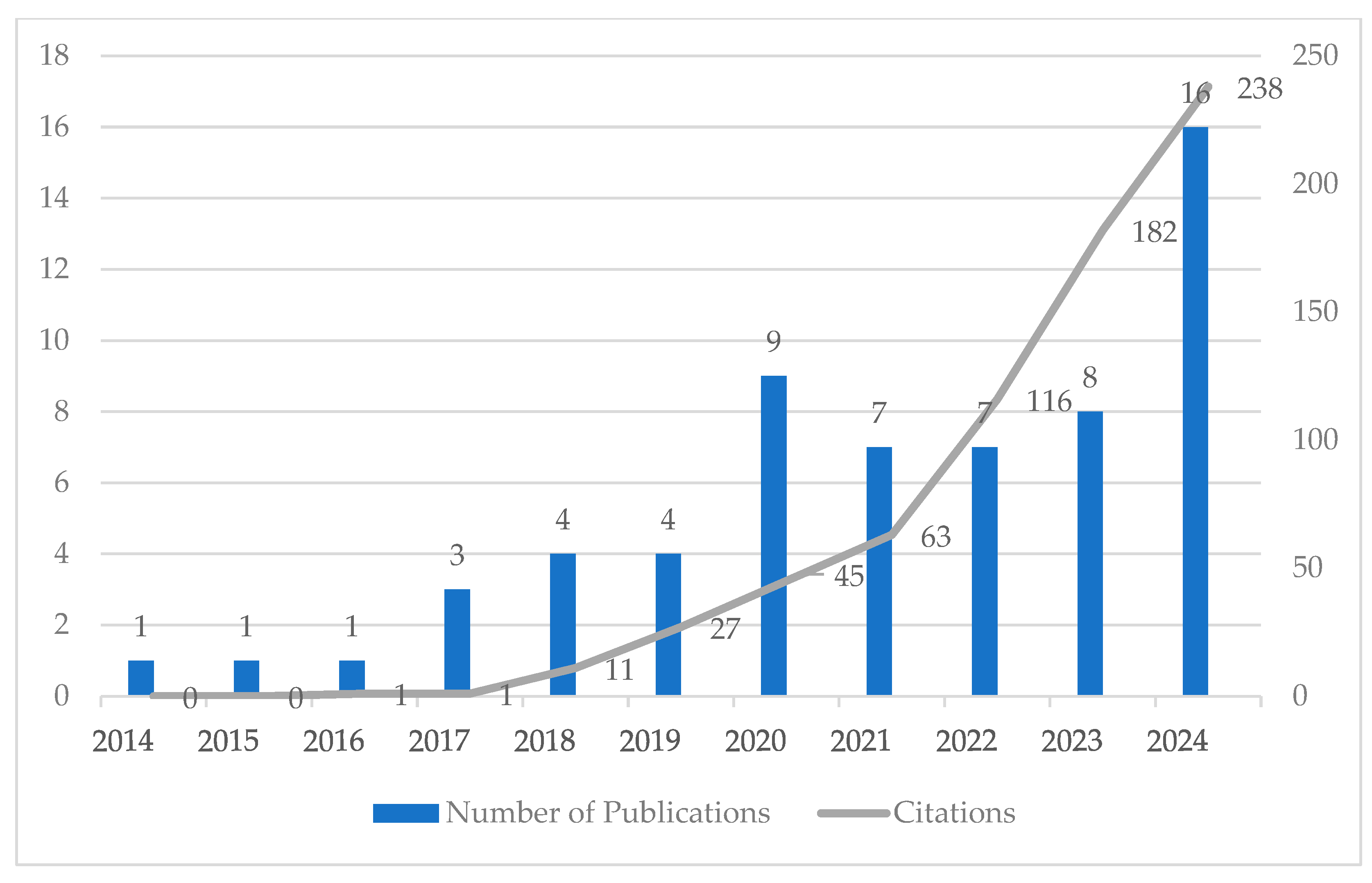

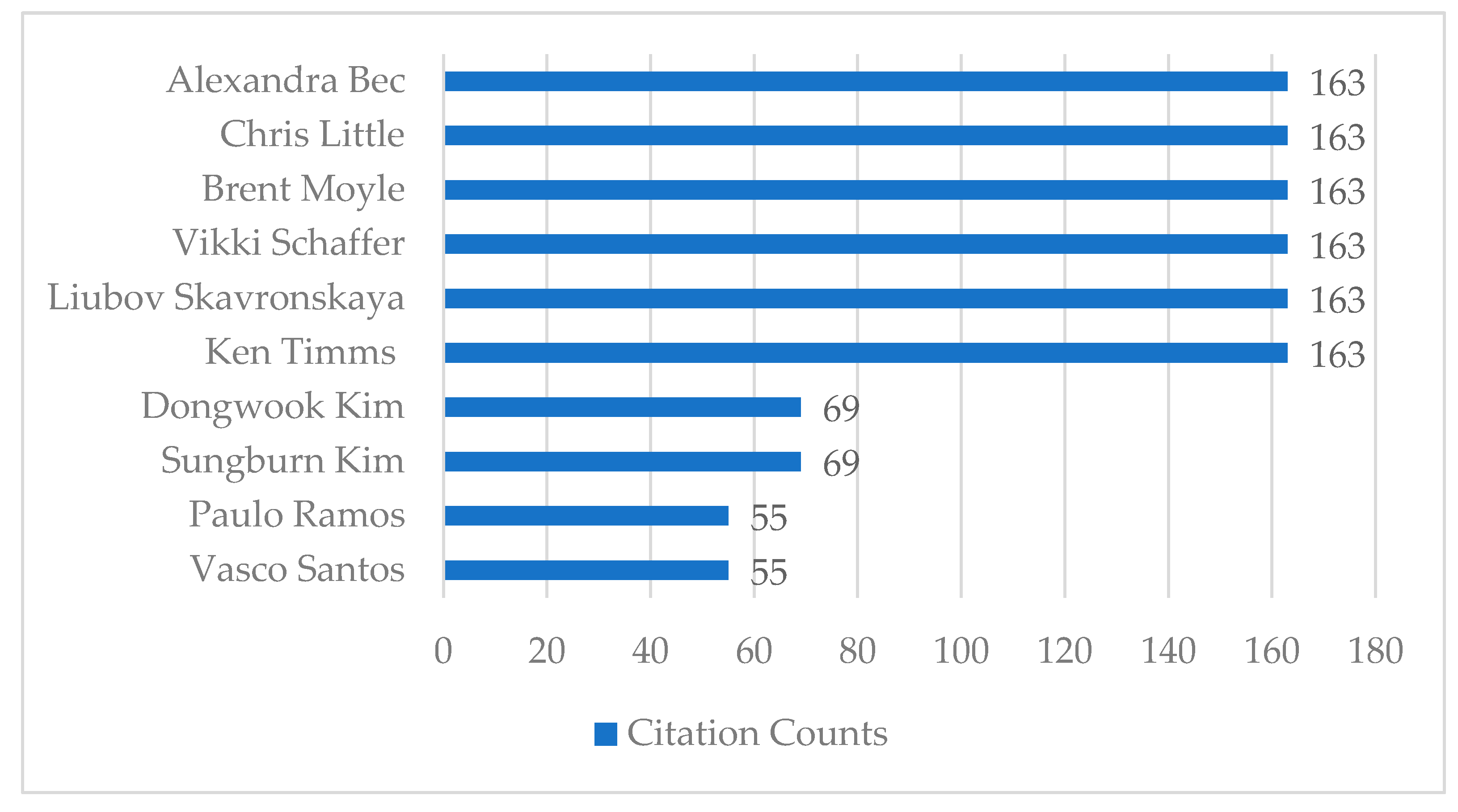
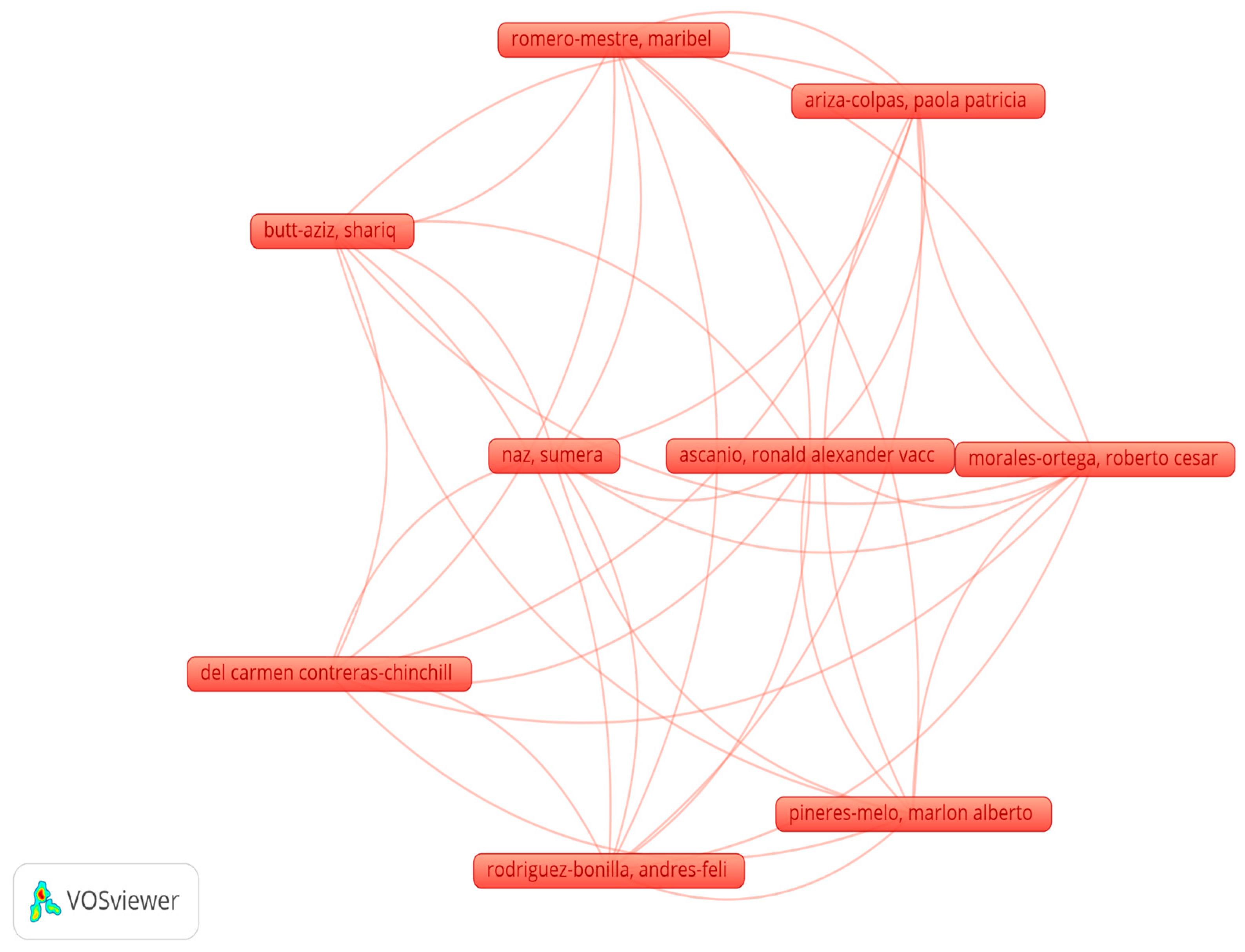
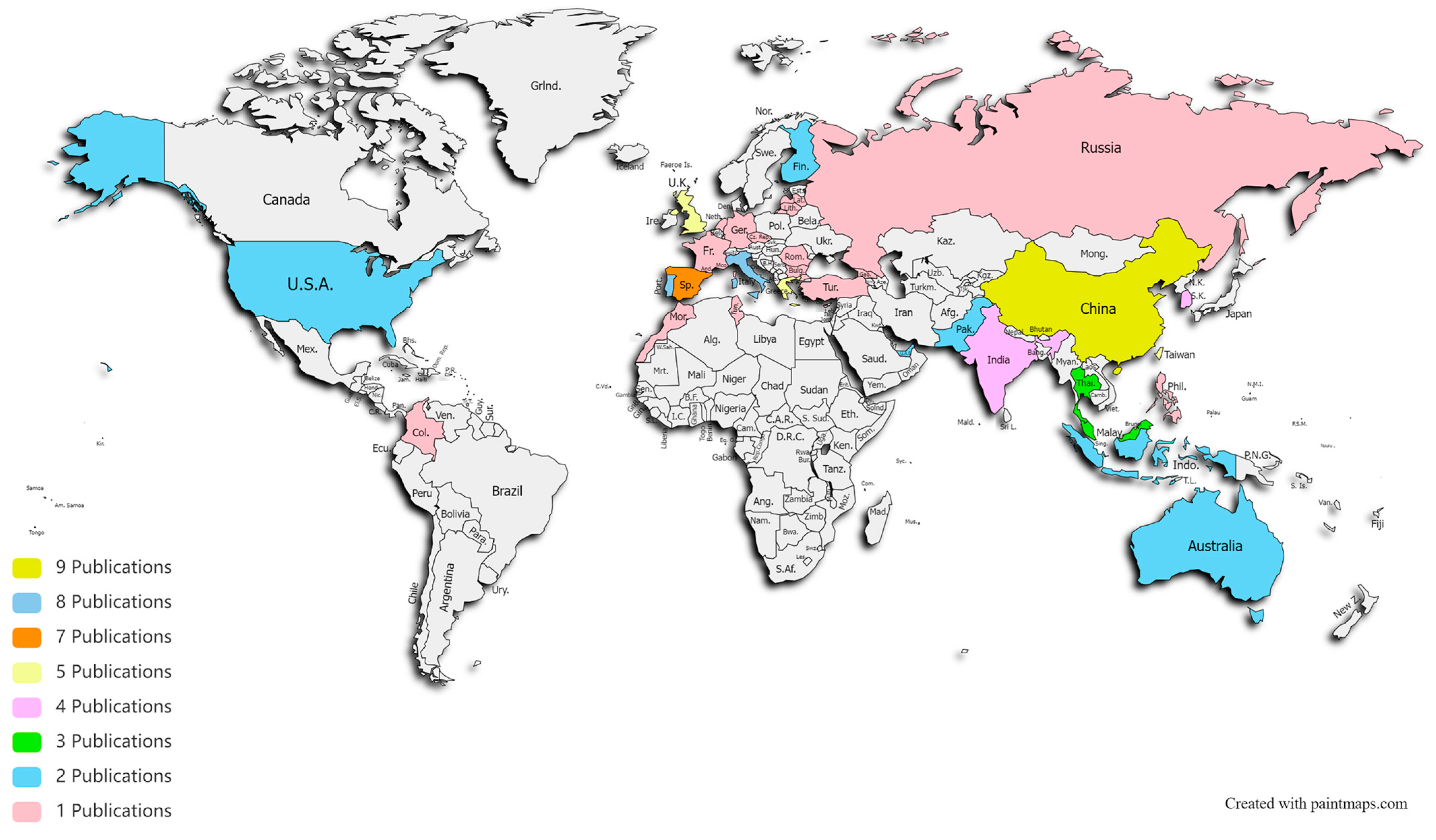


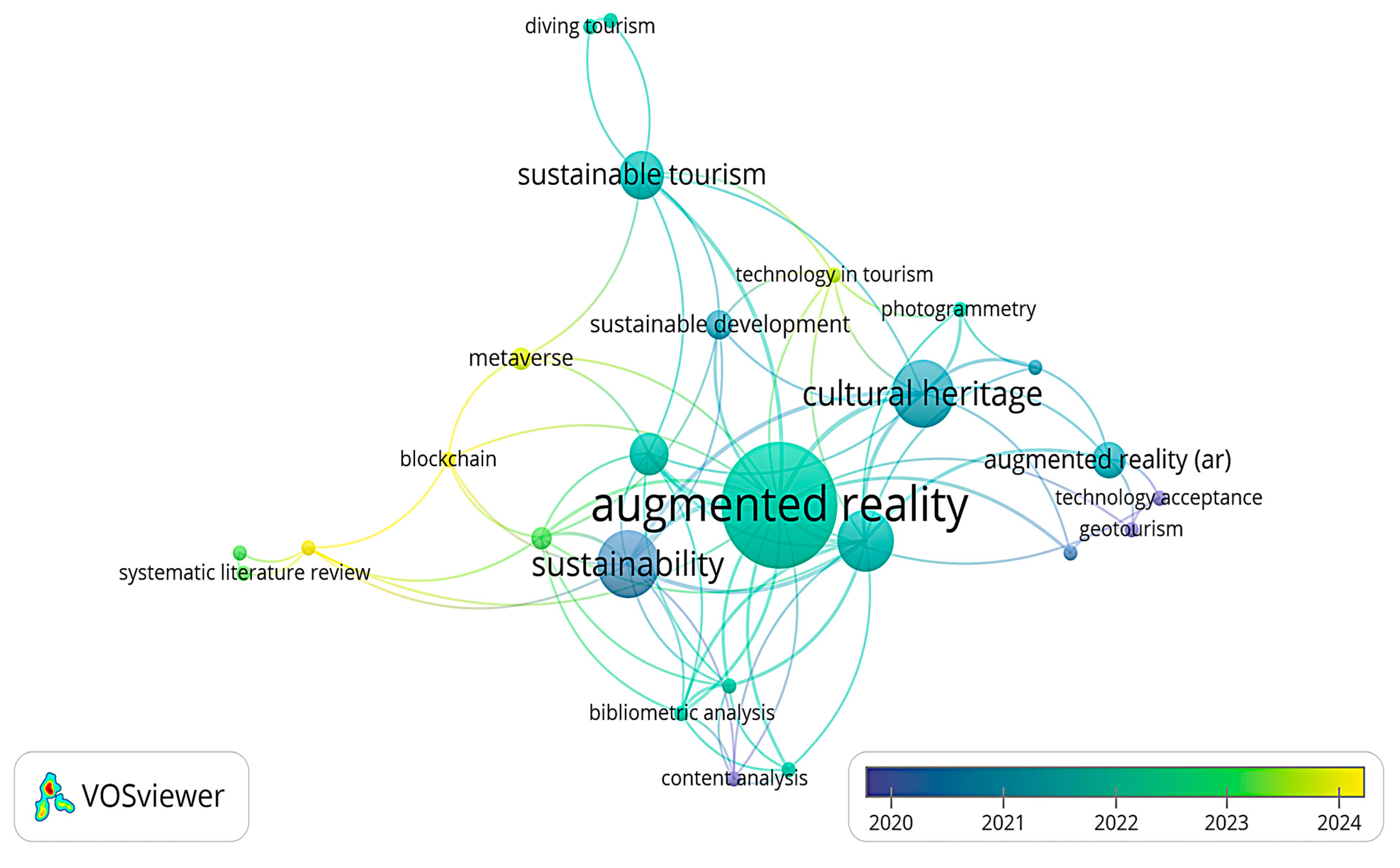
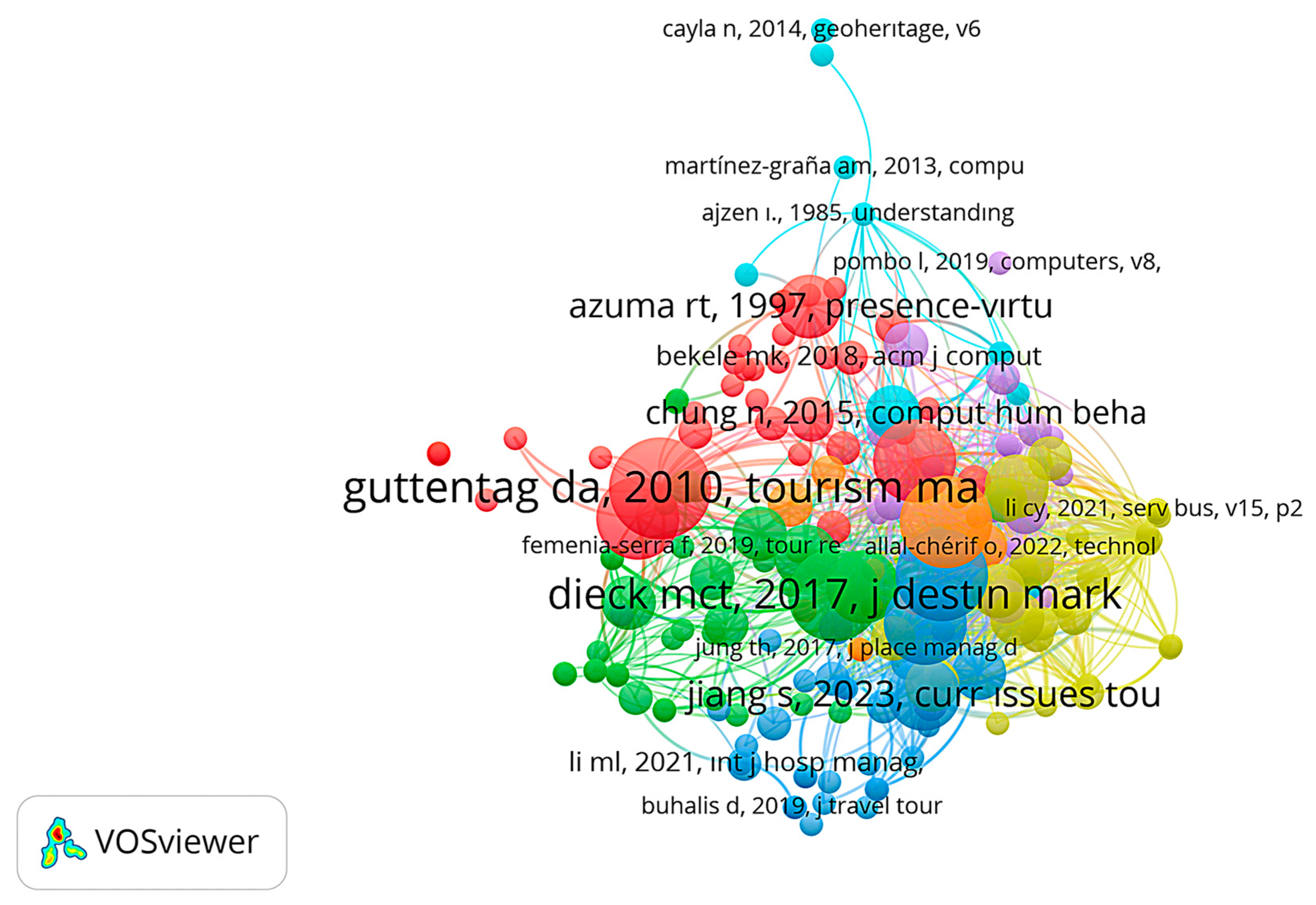
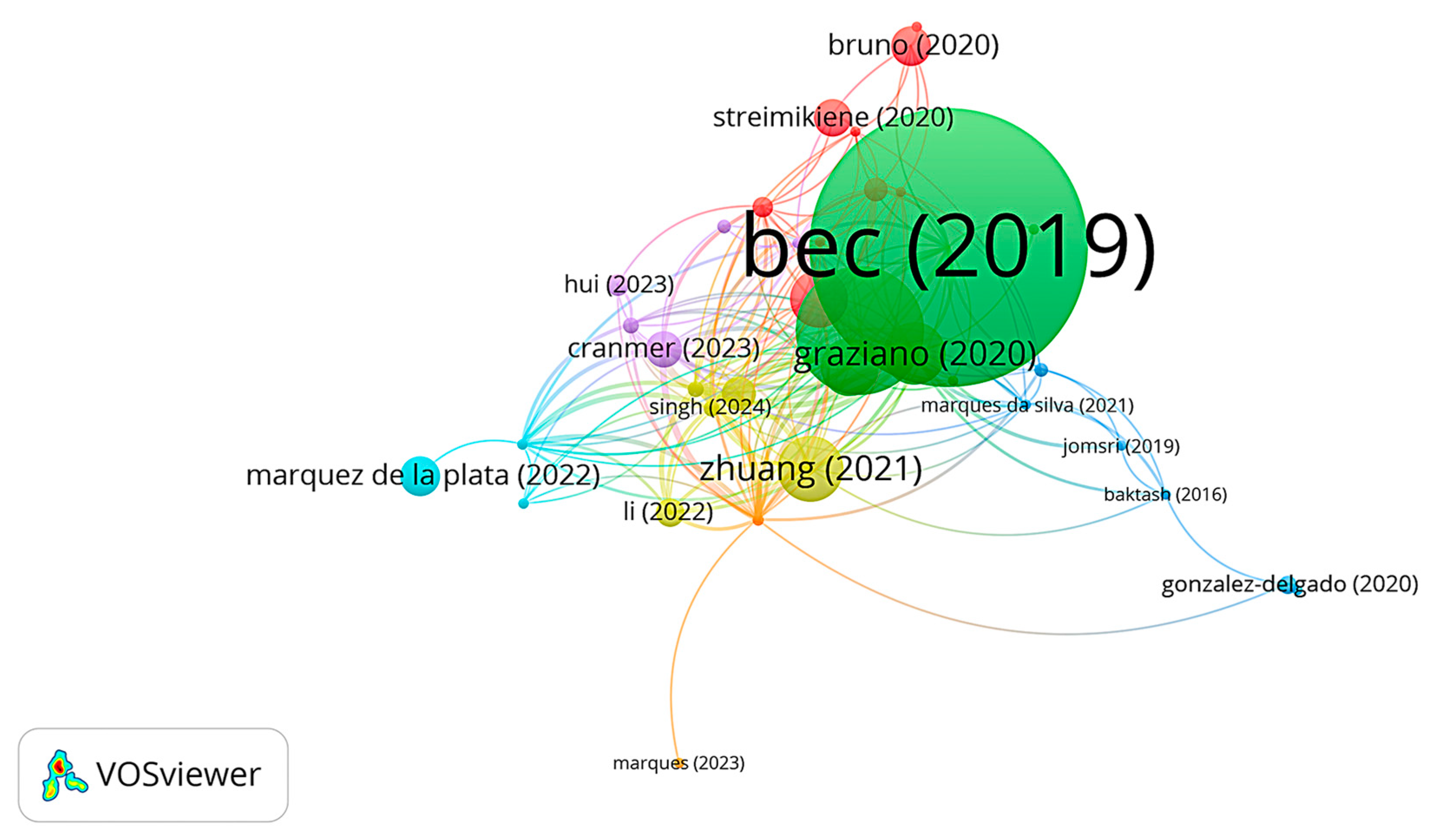

| Country | Citation Count | Number of Publications | ANC * Per Publication |
|---|---|---|---|
| China | 239 | 9 | 26.5 |
| Australia | 165 | 2 | 82.5 |
| Italy | 126 | 8 | 15.7 |
| UK | 109 | 5 | 21.8 |
| Portugal | 100 | 8 | 12.5 |
| Republic of Korea | 96 | 4 | 24 |
| Spain | 70 | 7 | 10 |
| Greece | 38 | 5 | 7.6 |
| United States of America | 36 | 2 | 18 |
| Taiwan | 32 | 5 | 6.4 |
| Keyword | Occurrences * | TLS ** |
|---|---|---|
| augmented reality | 20 | 39 |
| cultural heritage | 10 | 20 |
| sustainability | 10 | 19 |
| tourism | 9 | 23 |
| sustainable tourism | 7 | 10 |
| virtual reality | 6 | 15 |
| augmented reality (AR) | 5 | 6 |
| sustainable development | 4 | 7 |
| artificial intelligence | 3 | 11 |
| metaverse | 3 | 4 |
| Author(s) and Publication Year | Title | TC * | AC ** | Journal/ Conference | Journal/ Conference Index | JIF *** |
|---|---|---|---|---|---|---|
| Bec et al., 2019 [46]. | Management of Immersive Heritage Tourism Experiences: A Conceptual Model | 164 | 23.43 | Tourism Management | SSCI | 10.9 |
| Kim and Kim, 2017 [47]. | The Role of Mobile Technology in Tourism: Patents, Articles, News, and Mobile Tour App Reviews | 69 | 7.67 | Sustainability | SSCI-SCIE | 3.3 |
| Santos et al., 2022 [48]. | Towards a Framework for the Global Wine Tourism System | 55 | 11 | Journal of Organizational Change Management | SSCI | 2.7 |
| Zhuang et al., 2021 [49]. | Subjective Norms, Attitudes, and Intentions of AR Technology Use in Tourism Experience: The Moderating Effect of Millennials | 34 | 5.67 | Leisure Studies | SSCI | 2.3 |
| Vela et al., 2017 [50]. | Visual Landscape as a Key Element of Place Branding | 33 | 3.67 | Journal of Place Management and Development | ESCI | 1.8 |
| Graziano and Privitera, 2020 [51]. | Cultural Heritage, Tourist Attractiveness and Augmented Reality: Insights from Italy | 32 | 5.33 | Journal of Heritage Tourism | ESCI | 3 |
| Sorokina et al., 2022 [52]. | Constructing a Smart Destination Framework: A Destination Marketing Organization Perspective | 29 | 7.25 | Journal of Destination Marketing & Management | SSCI | 8.9 |
| Loureiro and Nascimento, 2021 [53]. | Shaping a View on the Influence of Technologies on Sustainable Tourism | 29 | 5.8 | Sustainability | SSCI-SCIE | 3.3 |
| Bruno et al., 2020 [54]. | Digital Technologies for the Sustainable Development of the Accessible Underwater Cultural Heritage Sites | 20 | 3.33 | Journal of Marine Science and Engineering | SCIE | 2.7 |
| Cirulis et al., 2015 [55]. | Virtualization of Digitalized Cultural Heritage and Use Case Scenario Modeling for Sustainability Promotion of National Identity | 20 | 1.82 | Conference on ICTE Regional Development | CPCI-S | - |
| Main Theme | Aims and References |
|---|---|
| Education (f = 6) | To reveal the role of mobile augmented reality games in sustainable development education and tourist experiences [83]. To analyze the need for sustainable tourism education and perceptions of AR usage in developing Islamic tourism [90]. |
| To investigate the contribution of AR and VR technologies in educating tourists about regenerative tourism and their tendencies towards this type of tourism [77]. To explore the available training on offer regarding AR in the tourism sector in Europe [91]. | |
| To determine the role of AR technology in improving visitors’ awareness, satisfaction, and learning experiences in intangible cultural heritage exhibitions [82]. To educate visitors about the infrastructure of a park and attract attention toward conservation and sustainability [88]. | |
| Tourism Experiences (f = 15) | To determine a framework for experience co-creation in cultural heritage tourism using AR technology [43]. |
| To explore how AR technology can improve the sustainability of tourist attractions and how it can benefit businesses beyond enhanced visitor experiences [6]. | |
| To examine the role of AR in tourists’ sustainable tourism experiences [74]. To explore the capabilities of VR and AR in enhancing the tourism experience and addressing physical travel constraints [92]. To reveal the determinants of tourists’ behavioral intention to accept AR wearable smart glass [79]. | |
| To explore the impact of AR technology on the formation of memorable tourism experiences within the framework of the technology acceptance model [93]. | |
| To determine the factors that affect tourists’ tendency to use AR in their visit experiences [49]. Applying mobile-based AR solutions in cultural events to enhance leisure experiences for tourists and support a sustainable city environment [94]. To classify a piece of cultural heritage found in some ruins and produce a 3D virtual model using innovative technologies as a virtual museum [95]. To propose a conceptual model of heritage preservation for integrating heritage into digital tourism experiences [46]. To provide a comprehensive overview of the evolution of AR in tourism and tourist experiences [96]. To offer a sustainable, interactive exploration game involving historical sites, enhancing the visitor experience [97]. To understand how animals are imagined and experienced and whether AR offers a viable alternative for wildlife tourism [98]. | |
| To explore the effect of AR experience on increasing the attractiveness of scenic zones and the sustainable development of enterprises [99]. To present a mobile AR application designed to encourage tourists in Finland to consume local food and have new experiences [100]. | |
| Data Sharing and Privacy Issues (f = 1) | To examine the current challenges relating to data sharing and data privacy in the metaverse environment, which includes technologies such as AR, VR, and the Internet of Things [101]. |
| Cultural Heritage Tourism (f = 15) | To reveal the role of technology (AR, VR, etc.) in sustainably improving the performance of both the tourism and cultural heritage sectors and their preservation [76]. To reveal the tourism resources of the Ribeira Sacra (Spain) and to present an updated inventory of cultural landscape of the region using AR technology [102]. |
| To examine the preservation of traditional elements and factories with AR technology [103]. To reconstruct, preserve, and promote heritage and water resources with the help of AR applications and immersive technologies [104]. To explore the integration of AR technology within the realm of cultural heritage tourism and its influence on tourists’ heritage responsibility behaviors [105]. To investigate the contribution of studies in cultural heritage to sustainability and AR-supported tourism [106]. To show the possibilities of VR and AR usage in training and the promotion of cultural heritage for the benefit of the users [107]. To investigate the role of AI, natural language processing, and AR in reshaping heritage preservation, visitor engagement, and sustainable growth [89]. To develop a baseline design and the use of VR and AR to find recommendations for the sustainability of the national identity of countries via the prism of cultural heritage [55]. To establish a business model for Petrila Theme Park using modern technologies such as AR [108]. To explore the potential of AR and VR technologies to be applied in heritage preservation in Africa [87]. | |
| To examine the valorization of underwater cultural heritage through digital applications for the promotion of diving destinations [109]. To explore the antecedents of the behavioral adoption of an AR mobile travel app related to visiting a heritage site considering sustainability [80]. To synthesize existing knowledge on technology integration in heritage tourism and identify AR’s ability to enhance historical sites [110]. To provide a critical analysis of tourism, specifically, presenting a post-COVID-19 perspective of urban cultural tourism based on sustainability and alternative technologies [111]. | |
| Innovation (f = 11) | To examine the impact of innovation in tourism within the scope of technologies such as AR and VR and to reveal the factors affecting the ability of businesses to manage innovation [112]. |
| To reveal the innovations brought about by the COVID-19 pandemic in tourism and the effects of technologies such as AR and VR on tourism marketing [75]. | |
| To examine the intersection of AR and tourism applications through the analysis of the perceived value of innovative AR solutions for destination stakeholders [51]. To strengthen the ICT level of tourism, especially the concept of big data analysis-based smart villages and using smart technologies (AR, VR, mixed reality, etc.) for sustainability [113]. | |
| To conduct a comparative bibliometric analysis of studies examining the impact of new technologies (such as AR, VR, and artificial intelligence) on sustainable tourism development [53]. To apply the notion of innovative digital content such as 360-degree images, 3D models, and AR to preserving the added value of touristic products and delivering this to the customer [114]. | |
| To develop a new framework for developing an innovative global wine tourism system [48]. To propose a theoretical construct related to the current consumption of landscape as a key symbolic and physical element in territorial representation, facilitating the deployment of a place branding strategy [50]. To review the tourism literature on digital transformation, including themes such as AR, VR, AI, and big data technologies; sustainability; and innovation [85]. To identify how destination management organizations can facilitate the development and effective governance of smart innovations [52]. To identify the wine tourism sector’s adoption of AR/VR innovation practices [115]. | |
| Mobile AR Applications (f = 13) | To develop an AR-based sustainable virtual tourism ecosystem and to reveal the geo-statistics of tourism regions [116]. |
| To examine mobile AR applications as an innovative way to attract tourists to destinations [117]. To develop a mobile AR application where physical structures can be virtually simulated, viewed, and controlled to promote the historical and cultural value of Malolos’ Kameztizuhan [86]. To develop environmental devices carried out with augmented reality to promote cultural heritage activities in Pompeii [118]. To reveal the status of mobile technology in achieving sustainable and smart tourism [47]. To implement a mobile AR application to advocate for Chiang Mai moat areas by presenting information as an AR demonstration [7]. | |
| To develop the Geoapp mobile AR application to show the original forms of the filmed areas to visitors and to introduce these areas [78]. | |
| To develop a new mobile AR application to increase the sustainability of cultural tourism [81]. To explore an application enhancing the interaction of visitors with cultural heritage via a mobile device and AR technology [119]. To describe a mobile application (HUSH) designed for the promotion of geoheritage, focusing on the naturalistic value within urban areas [120]. | |
| To create value-added tourist experiences in underwater diving with mobile augmented diving AR and VR applications [54]. To analyze the literature on VR+ technologies (extended, mixed, hyper, and augmented) and sustainable tourism to extract a future research agenda [121]. To present the architecture of a MIRAR (Mobile Image Recognition based on Augmented Reality) application, which allows for the development of a system used to interact with a museum’s objects [122]. |
| Potential Gap | Research Questions |
|---|---|
| Accessibility |
|
| Integrated Technologies |
|
| Eco-tourism |
|
| Economic Development |
|
| Responsible Tourism |
|
Disclaimer/Publisher’s Note: The statements, opinions and data contained in all publications are solely those of the individual author(s) and contributor(s) and not of MDPI and/or the editor(s). MDPI and/or the editor(s) disclaim responsibility for any injury to people or property resulting from any ideas, methods, instructions or products referred to in the content. |
© 2025 by the authors. Licensee MDPI, Basel, Switzerland. This article is an open access article distributed under the terms and conditions of the Creative Commons Attribution (CC BY) license (https://creativecommons.org/licenses/by/4.0/).
Share and Cite
Ercan, F.; Sayın, K.; Dalgın, T.; Gençer, K. A Bibliometric and Systematic Review of Publications on Augmented Reality in Sustainable Tourism. Sustainability 2025, 17, 1508. https://doi.org/10.3390/su17041508
Ercan F, Sayın K, Dalgın T, Gençer K. A Bibliometric and Systematic Review of Publications on Augmented Reality in Sustainable Tourism. Sustainability. 2025; 17(4):1508. https://doi.org/10.3390/su17041508
Chicago/Turabian StyleErcan, Fatih, Kürşad Sayın, Taner Dalgın, and Kansu Gençer. 2025. "A Bibliometric and Systematic Review of Publications on Augmented Reality in Sustainable Tourism" Sustainability 17, no. 4: 1508. https://doi.org/10.3390/su17041508
APA StyleErcan, F., Sayın, K., Dalgın, T., & Gençer, K. (2025). A Bibliometric and Systematic Review of Publications on Augmented Reality in Sustainable Tourism. Sustainability, 17(4), 1508. https://doi.org/10.3390/su17041508







